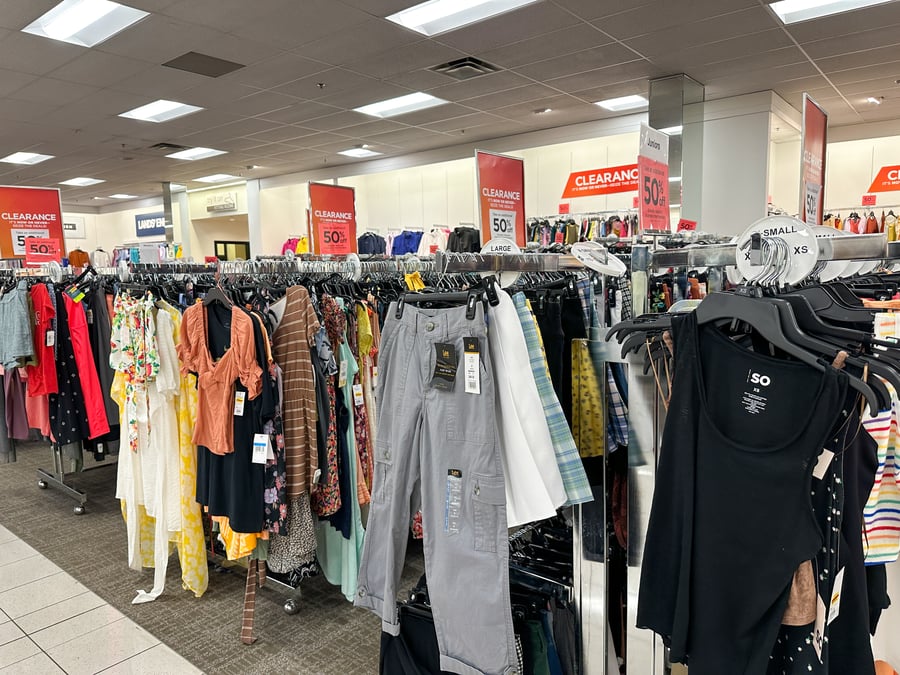Lina Chindamo is a Certified Credit Professional with over 25 years of experience in credit risk management. She has held senior leadership positions at companies like Sony Electronics, Maple Leaf Foods, and Mondelez Canada. Her extensive experience and current role, where she collaborates with c-suite partners and credit teams across various industries, make her a respected figure in the credit industry.
Rising inflation and a looming recession have created financial pressures for U.S. retailers.
At the same time, many retailers are grappling with a surplus of inventory from the previous holiday season.
Once the holiday shopping season is over, retailers face a new problem – leftover inventory and an influx of returns. According to U.S. Census data, retailers were sitting on $548.8 billion of inventory in July 2022 – a 21.6% increase from the previous year. And things aren’t looking all that great this year either. Not being able to unload excess inventory will lead to a host of challenges.
Challenge 1: Cash flow and accrued interest
Companies usually use cash flow from sales to pay back debts associated with the purchase of the inventory. But the longer the inventory doesn’t sell, the more interest accrues on that debt. If that debt becomes too much to manage and you can’t pay it back, then bankruptcy could be on the horizon.
In 2022, we saw major US retailers looking for ways to offload excess stock – and the impact it was having on their revenue. And this has been one of the biggest challenges retailers have faced in the run-up to the 2023 holiday shopping season.
According to Creditsafe data, U.S. retail bankruptcies increased by 64.75% in the first half of 2023, compared to the same period in 2022. But I decided to take a closer look at the bankruptcy data and see how different things have been across the country. Unfortunately, our data shows that retailers in Maine, Kentucky, South Carolina, Louisiana and Missouri have been struggling quite a bit this year.
Find the hidden risks in your supply chain
Maine: Retail bankruptcies rose 700% in the first half of 2023
According to Creditsafe data, retail bankruptcies in Maine rose 700% in the first half of 2023, compared to the same period last year. That’s a drastic increase year-over-year. Part of this is likely due to rising inflation and hikes in interest rates. But it’s also likely retailers in this state have had too much debt on their books without enough income. And that’s probably been made worse by the fact that consumers have tightened their belts amidst a looming recession – and holding back on unnecessary purchases.
One of the largest casualties that originally started in Maine was Olympia Sports, which filed for Chapter 11 bankruptcy in 2022. This was motivated by wanting to retain staff and lower its retail footprint. But when I took a closer look at the data, I could see several warning signs for quite some time. For instance, our data shows that Olympia Sports has a DBT of 91 days – meaning they typically pay their invoices 91 days past the agreed upon payment terms. That would explain why 74% of the retailers invoices are past due – amounting to over $5 million in owed payments.
Kentucky: Retail bankruptcies rose 700% in the first half of 2023
As Creditsafe data reveals, Kentucky retailers have had their fair share of financial problems. In fact, retail bankruptcies rose 700% in the first half of the year, compared to the same period last year.
Who can forget the bankruptcy drama surrounding Bed Bath & Beyond from earlier this year? The fall of the brand was down to a few things, including fierce competition from other home goods retailers like Target and a poorly executed private label strategy. And then it was finally purchased by online ecommerce giant Overstock. This has led to Bed Bath & Beyond stores across the U.S., including two in Kentucky, being shut down permanently.

South Carolina: Retail bankruptcies rose 600% in the first half of 2023
Our data shows that another state – South Carolina – isn’t too far behind Maine and Kentucky when it comes to bankruptcies. In the first half 2023, retail bankruptcies in the state jumped up 600% compared to the same period last year. And I’d bet anything that a big part of this is down to rising inflation, the cost-of-living crisis and a decline in consumer spending.
Discount home goods store Tuesday Morning felt this pressure and filed for bankruptcy for the second time in three years. A corporation that once had an annual turnover of $1 billion was forced to close 13 stores in South Carolina.
Louisiana: Retail bankruptcies rose 250% in the first half of 2023
Similar economic issues have plagued Louisiana, with employment statistics highlighting a bigger problem at hand. A recent survey found that the working-age population of 16 – 64 year olds dropped to 3.6 million in May 2023, down 10,600 from the previous year.
Wedding retailer David’s Bridal found itself filing for bankruptcy in 2018 due to being $400 million in debt. Then in 2022, it filed for bankruptcy again, which put its Louisiana stores in jeopardy. Luckily, it was saved through a buyout by Cion Investment Corp.

Missouri: Retail bankruptcies rose 300% in the first half of 2023
A cautionary tale from Missouri is the downfall of Party City. The party supplies retailer lost money every year between 2019 and 2021 and finally filed for bankruptcy in 2023 because of increasing competition, holiday inflation and a helium shortage for key products. As a result, several stores in Missouri closed.
Matthew Debbage, CEO of the Americas and Asia for Creditsafe, had some interesting points about this particular retailer’s downfall.
“Although the financials for Party City weren’t as bleak as they were for Bed Bath & Beyond, I think the troubled economic climate had a lot to do with their financial woes. In times like these, the first thing people and businesses do is clamp down on unnecessary spending – and parties tend to fall into that category. So, as people are less inclined to spend a lot of money on celebrations and parties, they’re not going to spend their money on party supplies.”
Challenge 2: Increased warehousing costs
The next problem to consider is the cost of storing excess inventory. It’ll eat into your cash flow and take up space that should be reserved for more profitable items that sell well during the holiday shopping season. Let’s look at Walmart. The company reported that in the first quarter of 2023 it had a 32% increase in inventory because of inflation and supply chain issues.
The direct consequences of that include stacking pallets and boxes in stores, overcrowding and blocked bathrooms. The knock-on effect was employee dissatisfaction, customer annoyance and damaged brand reputation.
The solution here is effective inventory management ahead of the holidays. Here are some best practices for decreasing warehouse costs and moving excess inventory:
- Decide what your most popular products are going to be for the holiday season, including Black Friday and Cyber Monday. One way to do this is the ABC analysis. A is your big-ticket items, B is for middle-priced products and C is for products that have the lowest value.
- Choose the right inventory replenishment stock method. For a major event like Christmas, this could be periodic ordering because you know certain goods have historically sold well during November and December.
- Make sure you have full visibility of goods that are at risk of becoming obsolete stock to avoid your profit margin being impacted. Identify these products and turn an obstacle into a solution through bundling and upselling campaigns.

Challenge 3: Inventory value decreasing over time
Following on from my last point, obsolete stock is always a risk in business, particularly when goods are just sitting in a warehouse for months on end, hurting cash flow. This decrease in product value is usually down to poor buying practices or a failure to accurately forecast inventory for arguably the biggest quarter of the retail year.
Also, changing customer preferences have led to a shift in the types of items that are in high demand. In the first two years of the pandemic, products like hoodies and leisure wear were popular. Now, there’s a demand for party dresses and office clothes.
A business that has had to adapt rapidly to the challenge of decreasing inventory value is Target. The organization cut profit margin expectations for the second quarter of 2023 and recalibrated in a promising direction. According to CEO Brian Cornell: “We thought it was prudent for us to be decisive, act quickly, get out in front of this, address and optimize our inventory in the second quarter — take those actions necessary to remove the excess inventory and set ourselves up to continue to be guest relevant with our assortment.”
Challenge 4: Discounting to get rid of excess stock
Discounting has become one of the most common methods for moving bloated inventory. Two thirds of retailers expect consumers to be hunting for discounts during the 2023 holiday shopping season.
On paper, this sounds like a smart, logical decision. Discounts are a compelling reason for people to buy more items. But when you’re offering widespread discounts, this can get out of hand and severely impact your bottom line.
Gap, a hugely popular retailer, felt the sting of excessive discounting in 2022 when product margins fell by 5% year on year, with over half of the increase due to higher discounting. The company has learned from its mistake by vowing to be more proactive in chasing inventory, digging deeper into customer trends and further refining its inventory management.

Challenge 5: Sustainability issues
Now, let’s talk about the consequences of physically destroying excess inventory and how it impacts sustainability. The more stock that’s piling up, the more packaging waste that’s left behind. There’s an energy cost that comes from storing goods in warehouses. It’s a significant drain on natural resources and can have a damaging effect on the environment.
Sustainability is also tied to a supply chain of ethical suppliers. Working with people who oversupply you and provide goods that are bad for the environment is only going to add to your problems. Make sure you’ve done a thorough vetting process with suppliers and hold them accountable for their sustainable practices.
And remember that inventory management isn’t just about supply chain and procurement concerns. CFOs and finance teams should collaborate with the procurement department and bring in proper financial planning and forecasting.

About the Author
Lina Chindamo, Director, Enterprise Accounts, Creditsafe Canada